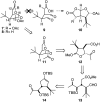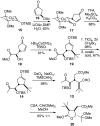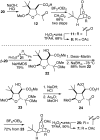Golgi-modifying properties of macfarlandin E and the synthesis and evaluation of its 2,7-dioxabicyclo[3.2.1]octan-3-one core
- PMID: 20332207
- PMCID: PMC2851978
- DOI: 10.1073/pnas.1001421107
Golgi-modifying properties of macfarlandin E and the synthesis and evaluation of its 2,7-dioxabicyclo[3.2.1]octan-3-one core
Abstract
Golgi-modifying properties of the spongian diterpene macfarlandin E (MacE) and a synthetic analog, t-Bu-MacE, containing its 2,7-dioxabicyclo[3.2.1]octan-3-one moiety are reported. Natural product screening efforts identified MacE as inducing a novel morphological change in Golgi structure defined by ribbon fragmentation with maintenance of the resulting Golgi fragments in the pericentriolar region. t-Bu-MacE, which possesses the substituted 2,7-dioxabicyclo[3.2.1]octan-3-one but contains a tert-butyl group in place of the hydroazulene subunit of MacE, was prepared by chemical synthesis. Examination of the Golgi-modifying properties of MacE, t-Bu-MacE, and several related structures revealed that the entire oxygen-rich bridged-bicyclic fragment is required for induction of this unique Golgi organization phenotype. Further characterization of MacE-induced Golgi modification showed that protein secretion is inhibited, with no effect on the actin or microtubule cytoskeleton being observed. The conversion of t-Bu-MacE and a structurally related des-acetoxy congener to substituted pyrroles in the presence of primary amines in protic solvent at ambient temperatures suggests that covalent modification might be involved in the Golgi-altering activity of MacE.
Conflict of interest statement
The authors declare no conflict of interest.
Figures








Similar articles
-
Enantioselective Total Synthesis of Macfarlandin C, a Spongian Diterpenoid Harboring a Concave-Substituted cis-Dioxabicyclo[3.3.0]octanone Fragment.Angew Chem Int Ed Engl. 2020 Apr 6;59(15):6268-6272. doi: 10.1002/anie.201916753. Epub 2020 Feb 19. Angew Chem Int Ed Engl. 2020. PMID: 31965671 Free PMC article.
-
Divergent synthesis and chemical reactivity of bicyclic lactone fragments of complex rearranged spongian diterpenes.J Am Chem Soc. 2011 Nov 2;133(43):17494-503. doi: 10.1021/ja207727h. Epub 2011 Oct 11. J Am Chem Soc. 2011. PMID: 21988207 Free PMC article.
-
Versatile Construction of 6-Substituted cis-2,8-Dioxabicyclo[3.3.0]octan-3-ones: Short Enantioselective Total Syntheses of Cheloviolenes A and B and Dendrillolide C.J Am Chem Soc. 2017 May 31;139(21):7192-7195. doi: 10.1021/jacs.7b04265. Epub 2017 May 22. J Am Chem Soc. 2017. PMID: 28514145
-
General Access to Concave-Substituted cis-Dioxabicyclo[3.3.0]octanones: Enantioselective Total Syntheses of Macfarlandin C and Dendrillolide A.J Org Chem. 2020 Dec 4;85(23):15532-15551. doi: 10.1021/acs.joc.0c02273. Epub 2020 Nov 16. J Org Chem. 2020. PMID: 33197184
-
Chemical biology studies on norrisolide.Bioorg Med Chem. 2010 Mar 15;18(6):2115-2122. doi: 10.1016/j.bmc.2010.02.007. Epub 2010 Feb 10. Bioorg Med Chem. 2010. PMID: 20189813 Free PMC article.
Cited by
-
Enantioselective Total Synthesis of Macfarlandin C, a Spongian Diterpenoid Harboring a Concave-Substituted cis-Dioxabicyclo[3.3.0]octanone Fragment.Angew Chem Int Ed Engl. 2020 Apr 6;59(15):6268-6272. doi: 10.1002/anie.201916753. Epub 2020 Feb 19. Angew Chem Int Ed Engl. 2020. PMID: 31965671 Free PMC article.
-
Total Synthesis of (-)-Chromodorolide B.J Am Chem Soc. 2016 Feb 24;138(7):2186-9. doi: 10.1021/jacs.6b00541. Epub 2016 Feb 16. J Am Chem Soc. 2016. PMID: 26880210 Free PMC article.
-
A concise synthesis of (-)-aplyviolene facilitated by a strategic tertiary radical conjugate addition.Angew Chem Int Ed Engl. 2012 Sep 17;51(38):9576-80. doi: 10.1002/anie.201204977. Epub 2012 Aug 24. Angew Chem Int Ed Engl. 2012. PMID: 22926995 Free PMC article. No abstract available.
-
Transition Metal-Mediated C-C Single Bond Cleavage: Making the Cut in Total Synthesis.Angew Chem Int Ed Engl. 2020 Oct 19;59(43):18898-18919. doi: 10.1002/anie.201915657. Epub 2020 Aug 24. Angew Chem Int Ed Engl. 2020. PMID: 31984640 Free PMC article. Review.
-
Divergent synthesis and chemical reactivity of bicyclic lactone fragments of complex rearranged spongian diterpenes.J Am Chem Soc. 2011 Nov 2;133(43):17494-503. doi: 10.1021/ja207727h. Epub 2011 Oct 11. J Am Chem Soc. 2011. PMID: 21988207 Free PMC article.
References
-
- Donaldson JG, Finazzi D, Klausner RD. Brefeldin A inhibits Golgi membrane-catalysed exchange of guanine nucleotide onto ARF protein. Nature. 1992;360:350–352. - PubMed
-
- Renault L, Guibert B, Cherfils J. Structural snapshots of the mechanism and inhibition of a guanine nucleotide exchange factor. Nature. 2003;426:525–530. - PubMed
-
- Takizawa PA, et al. Complete vesiculation of Golgi membranes and inhibition of protein-transport by a novel sea sponge metabolite, ilimaquinone. Cell. 1993;73:1079–1090. - PubMed
-
- Radeke HS, Digits CA, Casaubon RL, Snapper ML. Interactions of (-)-ilimaquinone with methylation enzymes: Implications for vesicular-mediated secretion. Chem Biol. 1999;6:639–647. - PubMed
Publication types
MeSH terms
Substances
Grants and funding
LinkOut - more resources
Full Text Sources

